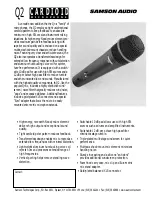
QST
®
– Devoted entirely to Amateur Radio www.arrl.org
January 2016 1
Desk Microphone
Power-On and
PTT Indicators
Know when power is applied to
your microphone, and when the
PTT is engaged.
Don Dorward, VA3DDN
Often one cannot tell just by looking at a
powered desk microphone whether it is
connected to dc power, or if the push-to-
talk (PTT) is engaged. You also can’t tell
if the PTT switch actually works, or worse,
if it has been accidently locked in transmit,
unless you are looking at the radio or the
RF output power meter. I decided to add
telltale LED indicators to my Icom SM-20
microphone that would glow in one color
when power is provided to the microphone,
and glow in a second color whenever the
PTT switch is engaged.
Guidelines
Don’t risk ruining the value of your micro-
phone — modifications should look pro-
fessionally done. Don’t risk shortening the
life of the PTT switch by running LED cur-
rent through it. Microphone PTT switches
are often just small tactile switches rated at
less than 20 mA. Don’t overload the radio
microphone power source; it is typically
rated +5 or 8 V dc at 25 mA maximum.
Finally, I kept my circuit small and simple
for anyone to build and install.
The Circuit
I built versions of my circuits using either a
two-lead bi-color LED, shown in Figure 1,
or two individual reverse-connected LEDs
with colors of your choice (see the sidebar
“Color Blindness in Radio Amateurs”).
I chose green for the normal power-on
condition, and red to indicate that the PTT
is engaged. This circuit requires a micro-
phone with a PTT switch that connects to
radio ground for transmitting.
QS1601-Dorward01
LED1*
(red)
(grn)
R1
220 Ω
R3
270 Ω
R5
100 Ω
Kr
Kg
R4
4.7 kΩ
R2
3.3 kΩ
C1
C2
0.01
D1
1
2
3
Q1
BC547B
Q2
BC547B
16 V
2.2 μF
+8 V (5 V, R5=0)
(red wire)
To Radio PTT
(yel wire)
com/gnd
(blk wire)
1N5819
*
Bi-color red/grn
LED or two
separate LEDs in
parallel.
C1 — capacitor, 2.2
m
F 16 V tantalum
C2 — capacitor, 0.01
m
F 50 V ceramic
D1 — Schottky diode, 1N5819
LED1 — (see text), bi-color 3mm LED Jameco
#94553 or Digikey #160-1058-ND
Q1, Q2 — NPN transistor, BC547B, 2N2222,
2N440, 2N3904, or similar
Figure 1 — Schematic diagram for the microphone PTT indicator. LED1 is external to the printed
circuit board and may be either a single bi-color red/green LED, or two separate cross-connected
LEDs. Connect the cathode for the red LED to Kr, and the cathode for the green LED to Kg.
R1 — resistor, 220
W
5%
1
⁄
4
W
R2 — resistor, 3.3 k
W
5%
1
⁄
4
W
R3 — resistor, 270
W
5%
1
⁄
4
W
R4 — resistor, 4.7 k
W
5%
1
⁄
4
W
R5 — resistor, 100
W
5%
1
⁄
4
W
Transistors Q1 and Q2 do the polarity re-
versal. R1 and R3 set the individual LED
forward currents. Normally Q2 is
ON
and
Q1 is
OFF
. When the cathode of diode
D1 is grounded via the microphone PTT
switch, Q2 turns
OFF
and Q1 is
ON
. Con-
nect the green LED cathode to the collector
of Q2 (point Kg), and the red LED cathode
to the collector of Q1 (point Kr).
R5 sets the LED forward current for the
level of brightness you prefer. Icom radios
p8 V to the SM-20 microphone,
so I set R5 to 100
W
to supply a nominal
10 mA of LED forward current. R5 can be
replaced with a wire jumper for radios that
supply only 5 V.
Building the Circuit
The choice of components is not critical.
You can build the circuit on a piece perf-
board or on a PCB like I did (Figure 2).
There is limited space inside the SM-20
microphone. My PCB measures 1.2 by 0.73
inches and fits nicely into a corner (right
side of Figure 3) of the microphone base.
Reprinted with the permission on ARRL. Copyright © ARRL
January 2016, QST p59























